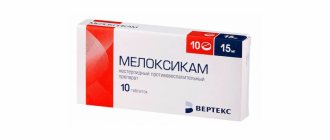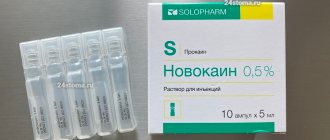Composition and release form
| Pills | 1 table |
| tramadol hydrochloride | 50 mg |
10 pcs in blister; There are 5 blisters in a box.
| Capsules | 1 caps. |
| tramadol hydrochloride | 50 mg |
10 pcs in blister; There are 2 blisters in a box.
| Oral solution | 1 ml |
| tramadol hydrochloride | 100 mg |
in dropper bottles of 10 or 20 ml; There is 1 dropper bottle in the box.
| Injection | 1 amp. |
| tramadol hydrochloride | 50 mg |
in ampoules of 1 ml; in a box there are 5 ampoules of 1 ml each.
| Injection | 1 amp. |
| tramadol hydrochloride | 100 mg |
in ampoules of 2 ml; in a box there are 5, 10 or 50 ampoules of 2 ml.
| Suppositories for rectal use | 1 sup. |
| tramadol hydrochloride | 100 mg |
10 pcs in blister; There are 1 or 2 blisters in a box.
When is Tramadol indicated?
The drug is used to reduce and eliminate pain of various origins:
- for physical injuries: dislocations, fractures, soft tissue ruptures, severe burns;
- consequences of surgical interventions;
- when performing invasive painful diagnostic procedures;
- in the later stages of malignant oncological tumors;
- after myocardial infarction;
- with neurological manifestations.
Injection forms of the drug, tablets, capsules and suppositories are approved for adults and children over 14 years of age. Tramadol drops can be used in patients from 1 year of age.
Directions for use and doses
The dosage is individual, depending on the intensity and nature of the pain, the duration and treatment regimen are determined by the doctor.
Tablets, capsules: orally, regardless of food intake, without chewing, with a small amount of liquid, or after dissolving in 1/2 glass of water, usually 1 tablet. or caps. (50 mg). If there is no effect within 30–60 minutes, the same dose can be repeated. For severe pain - 2 tables. or 2 caps. (100 mg) once.
Oral solution: with a small amount of liquid or with sugar, for adults and children over 14 years of age with a body weight over 50 kg, the initial dose is 20 drops, if the effect is insufficient, you can take the next dose after 30–60 minutes, repeat administration is possible after 4 –6 hours. The daily dose should not exceed 400 mg (160 drops). A single dose for children over 1 year of age is 1–2 mg/kg body weight. Approximate dosages for children: 1 year (10 kg) - 4-8 drops, 3 years (15 kg) - 6-12 drops, 6 years (20 kg) - 8-16 drops, 9 years (30 kg) - 12- 24 drops, 12 years (45 kg) - 18–36 drops.
Solution for injection: IV, IM, SC, for adults and adolescents over 14 years of age, a single dose is 1 ml; if there is no effect, the same dose can be repeated after 30–60 minutes. For severe pain - 50 mg every 4 hours, the daily dose should not exceed 400 mg, higher dosages are possible in the presence of a tumor or during surgery. For children from 1 to 13 years old, a single dose is 1–2 mg/kg body weight.
Suppositories: rectally, adults and adolescents over 14 years old, 1 suppository. (100 mg) depending on the intensity of pain, but not more than 400 mg (4 supp.).
In the presence of impaired liver and/or kidney function, as well as in elderly patients, an increase in the interval between doses is required.
How does Tramadol work?
The active substance of the drug, penetrating into the blood, binds to opioid receptors of various types in the brain and spinal cord. As a result, the production of pain neurotransmitters is reduced and the conductivity of neurons is inhibited. The intensity of painful sensations decreases, among other things, due to the effect of Tramadol on the receptors of the digestive tract.
- The drug inhibits the functioning of both cerebral hemispheres;
- has a calming effect;
- inhibits the cough reflex;
- affects the respiratory center.
The effect of use develops after 15–20 minutes and lasts up to 6 hours, depending on the intensity of the pain syndrome. The most effective dosage form is an injection solution. With prolonged use, the analgesic effect of Tramadol decreases, and the body requires a greater concentration of it.
The drug is metabolized in the liver tissues, part of it is excreted unchanged by the kidneys. The half-life of Tramadol can last up to 2 days or more in case of cholecystitis, hepatitis, hepatosis and other liver pathologies. The effect of the drug on the body continues.
In what cases is Tramadol prohibited?
The use of analgesics in all forms is excluded in case of individual intolerance to the active and auxiliary substances, alcohol abuse or poisoning, or dependence on psychoactive substances. Other contraindications:
- suicidal tendencies, severe clinical depression;
- renal and liver failure;
- undergoing treatment with certain psychotropic drugs;
- epilepsy that cannot be corrected with medications;
- first trimester of pregnancy.
In late pregnancy and lactation, Tramadol is prescribed in exceptional cases for individual indications.
Signs of use and consequences
Drug addicts manage to keep their addiction secret for a long time.
In many cases, loved ones find out about the disease at a serious stage, which complicates further treatment and rehabilitation of the patient. But addicts skillfully hide, so you should be especially attentive to teenagers and relatives. There are signs that indicate a person is taking drugs. To understand what to look for in the behavior and appearance of a dependent person, let’s consider several signs indicating the manifestation of dependence on a narcotic substance, in particular, the pharmaceutical drug in question:
- lethargy;
- violation of movement coordination;
- manifestation of inappropriate behavior, both at home and at work;
- aggression during chemical withdrawal;
- tremor of the limbs;
- limited interests;
- weight loss.
The life of a dependent person with a long experience is divided into two components. This is the period of action of the pharmaceutical drug and withdrawal of the substance. In search of a dose, drug addicts rarely stop; they do not think about the consequences of abuse. Moral and ethical values are being lost. A person radically changes his behavior. His family doesn't recognize him. Only a state of euphoria can return him to a relatively normal state. Since life is subordinated to the drug, a person loses his job, loses professional interests, and does not communicate with friends. He acquires new hobbies and accomplices who are also obsessed with finding a new dose. Changes in behavior should alert loved ones.
Withdrawal syndrome or withdrawal begins a few hours after stopping the drug. These are dangerous conditions that can have fatal consequences if medical care is not provided. Relatives can easily see the person’s difficult physical and psychological condition. He exhibits the following symptoms:
- excessive sweating;
- chills;
- temperature increase;
- convulsions;
- joint pain;
- headache;
- dizziness;
- stomach pain;
- nausea;
- vomit.
Withdrawal is a consequence of regular drug use. In addition to physical symptoms, the manifestation of mental ones is increasing. A person experiences anxiety and excitement, fear and horror, he is prone to panic.
In this situation, relatives need to contact narcologists at the Svoboda RC. You cannot hesitate, since the patient’s condition does not allow time for this. Doctors unanimously recommend cleansing the body of the drug and its breakdown products in a clinic. Only in the hospital all conditions have been created. If necessary, you can call a narcologist to your home from the Svoboda RC. The doctor will conduct detoxification therapy, but on the condition that the drug addict’s health condition does not cause him concern. You must be prepared for the fact that withdrawal will take place in a hospital in any case if the addict is elderly, has chronic pathologies, as well as a long history of using pharmaceutical and other drugs, when combined with alcoholic beverages.
If you suspect use, at the initial stage of use, when withdrawal symptoms are not so clearly manifested, you can do a drug test. The chemical is found in urine, blood and hair. Laboratory tests provide reliable results, since pharmacy tests can detect a limited amount of narcotic substances used by a person.
Tramadol is eliminated from the body in 6-7 hours, but much depends on the patient’s health status, length of use, weight and other characteristics. The body is completely cleansed in 3 days. Most of the pharmaceutical drug is excreted through the kidneys (90%), through the gastrointestinal tract - 10%.
TRAMADOL RETARD TAB. P/P/O PROLONG.HIGH. 200MG No. 10
In patients with opioid dependence, head injuries, shock, impaired consciousness of unknown etiology, breathing disorders or damage to the respiratory center, increased intracranial pressure, tramadol should be used only with extreme caution.
The drug should be used with caution in patients with known cases of severe opioid intolerance of allergic and non-allergic origin. Cases of seizures have been reported in patients taking tramadol at recommended doses. The risk of developing seizures may increase if the maximum recommended daily dose of the drug (400 mg) is exceeded. Taking tramadol may increase the risk of seizures in patients taking drugs that lower the seizure threshold. Patients with epilepsy and patients susceptible to seizures should take tramadol only for health reasons.
Concomitant use of tramadol and sedatives such as benzodiazepines or similar drugs may result in sedation, respiratory depression, coma and death. As a result, the concomitant use of tramadol with sedatives should only be considered when alternative treatment options are not available. When using tramadol and sedatives simultaneously, the minimum effective dose should be selected over the shortest possible course.
Close monitoring is necessary for signs and symptoms of respiratory depression and sedation. Therefore, it is strongly recommended that patients and their caregivers be informed about such symptoms.
When stopping treatment with tramadol, it is advisable to gradually reduce the dose to prevent withdrawal symptoms.
Tramadol is metabolized in the liver with the participation of the CYP2D6 isoenzyme. If there is insufficiency or absence of the CYP2D6 isoenzyme, it is impossible to obtain an adequate analgesic effect. It is estimated that approximately 7% of Caucasians may have CYP2D6 deficiency. In contrast, patients with high metabolic activity have an increased risk of developing adverse effects of opioid toxicity, even when taken at recommended doses.
Common symptoms of opioid toxicity include: confusion, drowsiness, shallow breathing, constricted pupils, nausea, vomiting, constipation and lack of appetite. In severe cases, symptoms of circulatory failure and respiratory depression are observed, which can be life-threatening and, in extremely rare cases, lead to death.
An estimate of the prevalence of rapid metabolizers in different populations is given below.
| Population | Prevalence (%) |
| Africans/Ethiopians | 29% |
| African Americans | 3,4%-6,5% |
| Asians | 1,2%-2% |
| Europeans | 3,6%-6,5% |
| Greeks | 6,0% |
| Hungarians | 1,9% |
| Scandinavians | 1%-2% |
According to data published in the literature, the use of tramadol in the postoperative period in children with obstructive sleep apnea syndrome after tonsillectomy and/or adenoidectomy led to the development of rare but life-threatening adverse events. Particular caution should be exercised when tramadol is used in children for postoperative pain management and close monitoring for symptoms of opioid toxicity, including respiratory depression.
Tramadol is not recommended for use in children with respiratory problems, including neuromuscular disorders, severe heart or respiratory disease, upper respiratory or lung infections, multiple traumas, or major surgery. These factors may increase symptoms of opioid toxicity.
It is possible to develop addiction, physical and mental dependence, especially with prolonged use.
In patients prone to drug abuse or the development of drug dependence, treatment with Tramadol retard should be carried out only in short courses and under medical supervision. Tramadol retard is not suitable as a replacement therapy for patients with opioid addiction. Although tramadol is an opioid agonist, it does not suppress morphine withdrawal symptoms.



